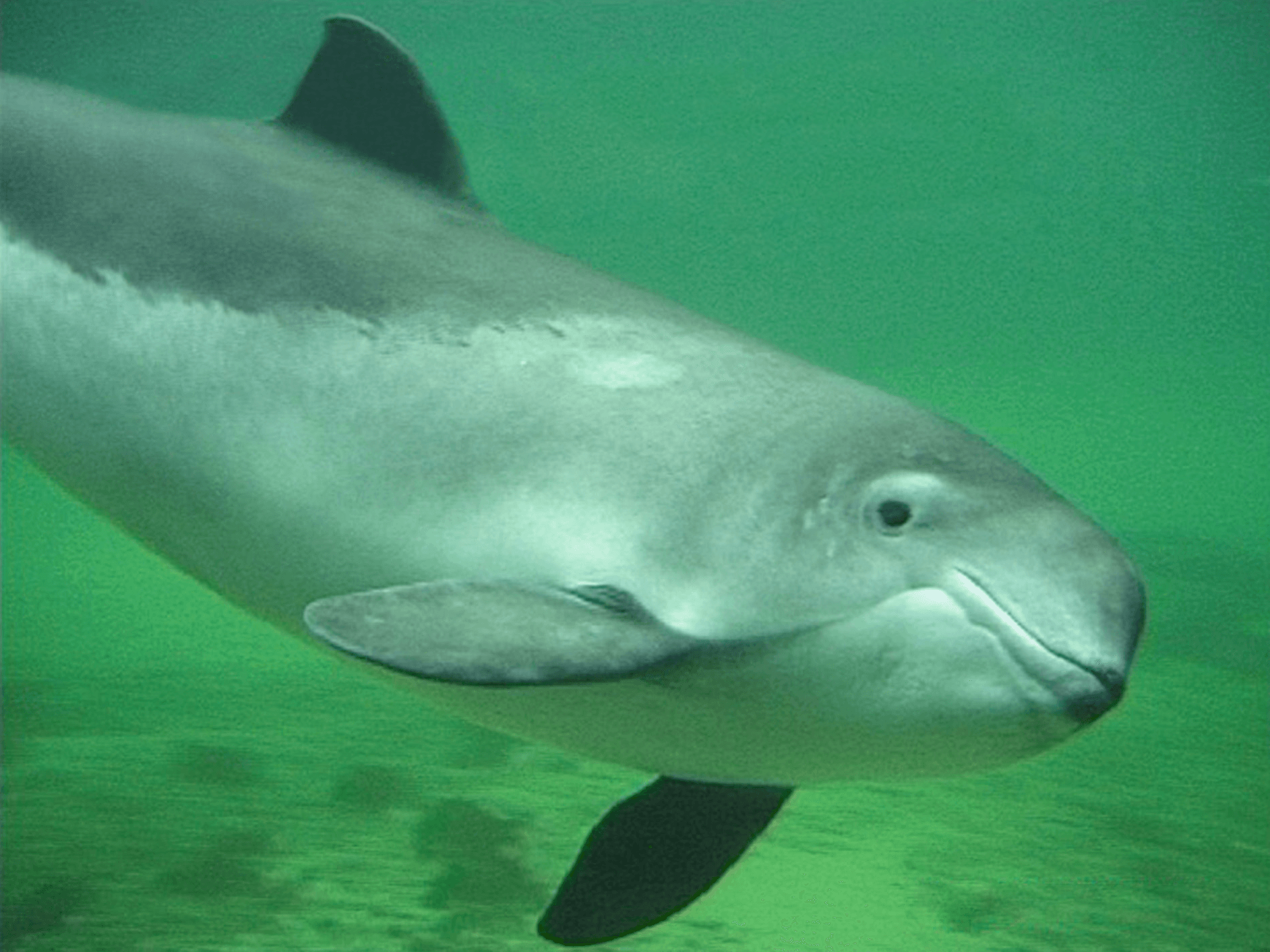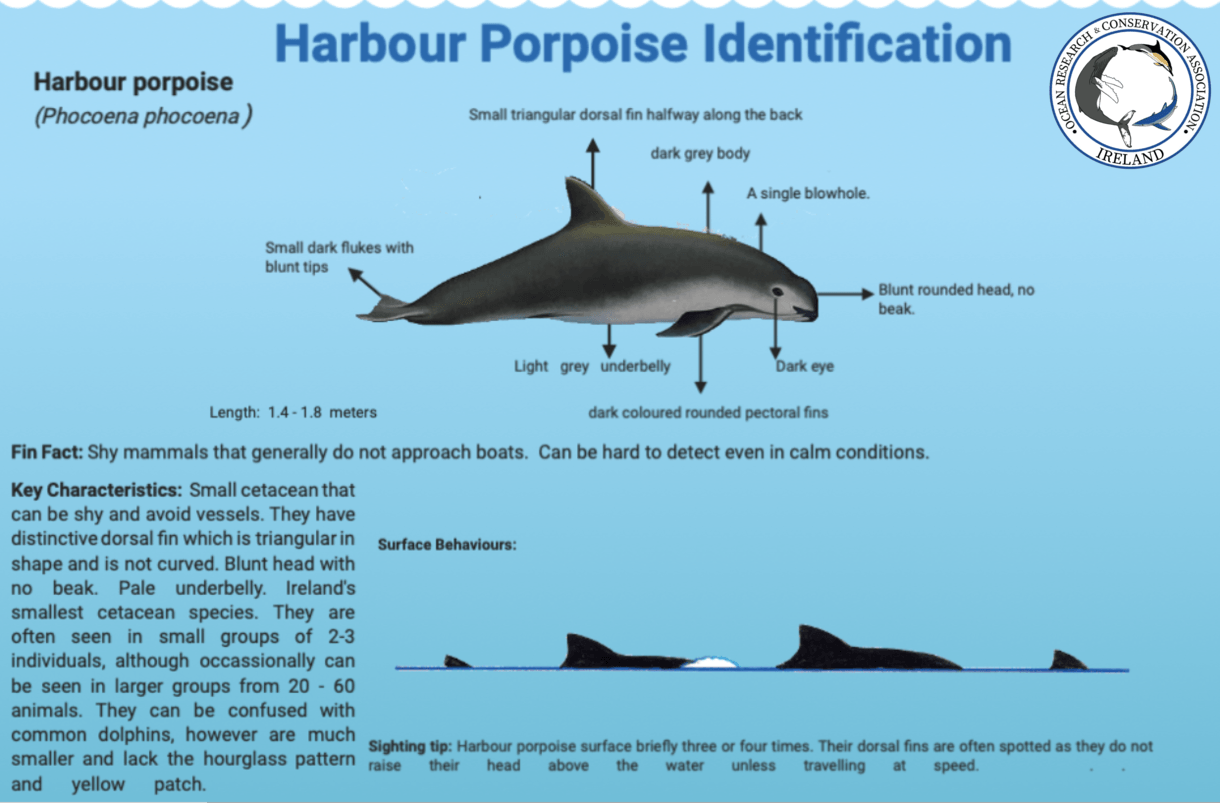Harbour porpoise
(Phocoena phocoena)
Next Species ----->
<-----Previous Species
Classification:
Kingdom:
Animalia
Phylum: Chordata
Class: Mammalia
Order: Artiodactyla
Infraorder: Cetacea
Family: Phocoenidae
Genus:
Phocoena
Species:
P.
phocoena
Get the Facts:
Harbour porpoise (Phocoena phocoena) are Ireland's smallest cetacean and one of the most common cetacean species here. Porpoises, along with whales and dolphins, are descendants of land-living ungulates (hoofed animals) that first entered the oceans around 50 million years ago (Mya).
Species Identification:
Harbour porpoise can be distinguished from dolphins at sea by their unique dorsal fin which is triangular. Stranded animals can be identified based on their teeth, which in comparison to dolphins who have pointed needle-like shaped teeth, porpoises have flattened spade-like teeth. They are very small (typically 1.5 meters in length) and have a bulbous head, no external ear flaps, a non-flexible neck, a torpedo shaped body. When feeding, they commonly surface to breathe about four times every 10 to 20 seconds before diving for up to six minutes. Harbour porpoises are also shy and tend to avoid boats and vessels. They can be hard to detect even in the calmest conditions.
Diet:
The harbour porpoise consumes a variety of species of fish, squid, octopus and shellfish. Herring, sprat and sand-eel make up a large part of their diet in Irish waters.
Habitat:
As its name implies, harbour porpoise stay close to coastal areas or river estuaries, and as such, is the most familiar porpoise to whale watchers. This porpoise often ventures up rivers, and has been seen hundreds of miles from the sea. In Ireland, harbour porpoise can be spotted from all coasts through-out the year but are more common along the east coast of Ireland. Some great places to spot them also include Inishowen Head, Co. Donegal.
Behaviour:
Harbour porpoises surface only briefly and the blow is not normally visible, although a puffing sound can be heard, earning this animal the nickname ‘puffing pig’. Generally thought of as being quite elusive animals, harbour porpoises will rarely approach vessels and they are not known for acrobatic surface displays, although they do breach on occasion. Generally they are observed moving slowly.
Social Structure:
The social life of harbour porpoises is not well understood. They are generally seen as a solitary species. Harbour porpoise are commonly seen in groups of two to five animals, although can be sighted in larger groups from 20 to 60 animals.
Vocalisations:
Like other odontocetes, harbour porpoises use echolocation for feeding and orientation. The dominant components of harbour porpoise echolocation signals are narrowband, high-frequency (ultrasonic) clicks within 110-150kHz. This is consistent with their hearing, with best sensitivity between 100 and 120 kHz. Click duration ranges from about 60 µs to 300 µs and the clicks are usually emitted in a series called a click train. Harbour porpoises produce intense click trains where the inter-click interval within a train ranges between 20 and 80 milli-seconds. This can decrease to less than 2 msec, especially when the animal is nearing its target: i.e., a fish. At this time the click train will actually sound more like a “buzz”.
Reproduction:
Porpoises mate promiscuously. Males produce large amounts of sperm, perhaps for sperm competition. Females become sexually mature by their third or fourth year and can calve each year for several consecutive years, being pregnant and lactating at the same time. The gestation of the porpoise is typically 10–11 months.Most births occur in late spring and summer. Calves are weaned after 8–12 months
Lifespan:
Their average life-span is 8–13 years, although individuals have reached 20 years old.
Global Distribution:
The harbour porpoise species is widespread in cooler coastal waters of the North Atlantic, North Pacific and the Black Sea. The populations in these regions are not continuous and are classified as separate subspecies with P. p. phocoena
in the North Atlantic and West Africa, P. p. relicta
in the Black Sea and Sea of Azov, an unnamed population in the northwest Pacific and P. p. vomerina
in the northeast Pacific.
Population Status:
The harbour porpoise has a global population of at least 700,000. In 2016, a comprehensive survey of the Atlantic region in Europe, from Gibraltar to Vestfjorden in Norway, found that the population was about 467,000 harbour porpoises, making it the most abundant cetacean in the region, together with the common dolphin. The highest densities are in the southwestern North Sea and oceans of mainland Denmark;[15] the latter region alone is home to about 107,000 harbour porpoises. Harbour porpoise are listed as Least Concern on the IUCN Red List, however in the Black Sea they are Critically Endangered.
Conservation Threats:
Harbour porpoises are vulnerable to many human activities that may disturb, injure or even kill them. As a result of their feeding habits, they are at a high risk of entanglement in fishing gear, particularly to gill nets. Harbour porpoise distribution overlaps with areas off the coast that are most heavily industrialised, particularly along the east coast. Thus, they are exposed to high levels of shipping traffic, coastal development, such as the development of offshore wind-farms and other human sources of disturbance. Hearing is the most important sense for porpoises, and so they are threatened by loud underwater noises caused by vessels, military activity and developments. In some areas Acoustic Deterrent Devices (ADDs) or commonly known as "pingers" are used by some fisheries to deter porpoises from nets and depredation.






